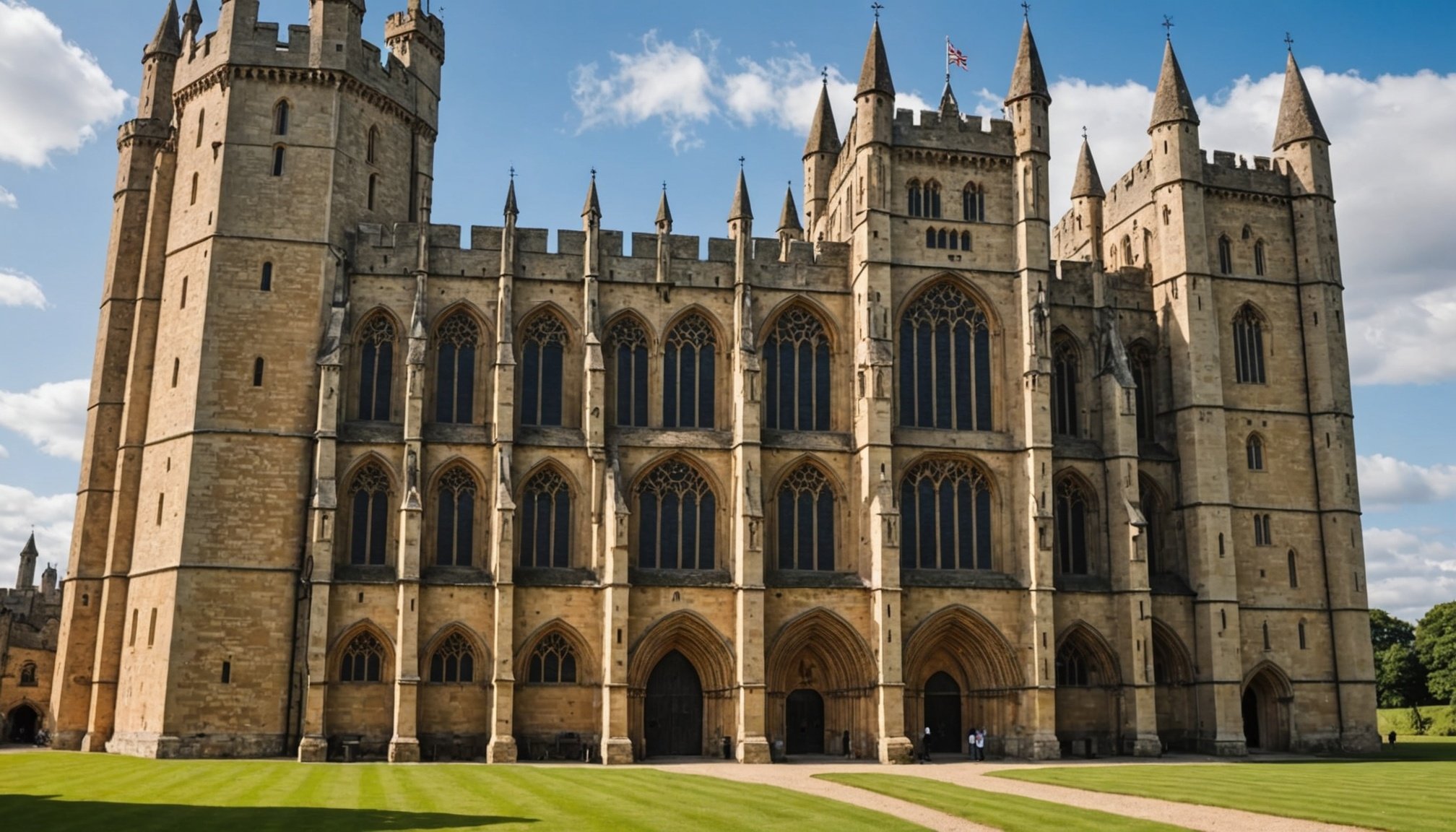Top Medieval Architecture Sites in the UK
Delve into the rich tapestry of medieval architecture across the UK, a testament to historical significance and artistry. Medieval architecture offers a profound glimpse into Britain’s storied past, witnessed in structures that have withstood the test of time. Across the UK, these architectural marvels highlight the ingenuity and vision of past societies, each with a unique narrative etched in stone.
Canterbury Cathedral
A beacon of historical significance, the Canterbury Cathedral dazzles with its Gothic architectural features and intricate stained glass windows. First founded in 597 AD, it has been a cornerstone of religious and cultural history. As visitors wander through its vast nave and adorned chapels, they’re offered glimpses of medieval craftsmanship at its finest.
This might interest you : Discover Britain’s Enigmatic Stone Circles: The Ultimate Guide to Memorable Tours Beyond Stonehenge
York Minster
York Minster stands as a monumental symbol of the medieval period, boasting an incredible Gothic style and exquisite stonework. The cathedral not only serves as a place of worship but also as a testament to the architectural achievements of its era. The Minster’s towering arches and detailed facades invite exploration into York’s rich architectural story.
Tower of London
Evolving through centuries, the Tower of London represents a key piece in England’s medieval architecture. Initially constructed by William the Conqueror in 1078, its fortifications narrate tales of monarchy and rebellion. Visitors can immerse themselves in the ancient stones that once guarded the kingdom’s cherished treasures.
This might interest you : Discover Pembrokeshire’s Breathtaking Sea Caves: Unforgettable Guided Kayak Experience Awaits!
Unique Architectural Features to Discover
Discover the unique features that make the UK’s medieval architecture truly remarkable. Many sites boast architectural highlights that serve as a testament to the medieval innovations of their era, setting them apart as masterpieces.
An exploration of Gothic architectural elements, notably in cathedrals, reveals the grandeur of medieval design. Intricate stone carvings, soaring vaults, and majestic spires are prevalent, showcasing skills that astound even today’s architects. For example, the ribbed vaults and flying buttresses of these structures not only functioned to support weight but also created a sense of breathtaking openness.
Regional styles can vary significantly, with different influences shaping the architecture. In the north, heavy Norman stonework often sets the tone, whilst southern examples may reflect more Romanesque influences. Examination of these regional styles reveals how local traditions and available materials influenced the architectural outcomes.
Lesser-known medieval architectural marvels await discovery, promising insights into the past’s artistry. Consider the elaborately carved misericords in some abbeys or the distinctively rugged castles dotting the countryside. Appreciating these architectural highlights deepens our understanding of the medieval innovations that laid foundational designs for future architecture worldwide.
Planning Your Visits
Embarking on a journey through the UK’s medieval architecture requires meticulous planning to ensure an enriching experience. Travel tips are indispensable for navigating popular sites like Canterbury Cathedral, York Minster, and the Tower of London. Understanding their opening hours is crucial—most cathedrals typically open from morning till early evening. During peak tourist seasons, it’s wise to book tickets in advance online to avoid lengthy queues. The best times to visit are often weekday mornings, which offer a more serene atmosphere.
When considering accommodations, proximity is key. For instance, historic inns in York offer a quaint stay near the Minster, while London provides a multitude of options ranging from budget-friendly to luxury lodgings.
Planning for amenities around these sites can greatly enhance your visit. Canterbury boasts delightful tea rooms and pubs that echo its storied past. In London, guided tours around the Tower district offer insights into local traditions and culture. Embrace these planning resources to unlock a seamless exploration of medieval architecture’s beauty and legacy in the UK.
In-Depth Location Descriptions
Delve into the captivating stories behind some of the UK’s most iconic medieval architectural sites. Each location tells its own tale, showcasing not only architectural brilliance but also deep historical significance.
Canterbury Cathedral
Canterbury Cathedral, a remarkable site of medieval architecture, boasts features like flying buttresses and gothic windows. Founded in 597 AD, it holds immense historical significance, serving as a centrepiece of England’s ecclesiastical history. When visiting, consider exploring nearby attractions such as the charming Westgate Gardens and the quaint St. Augustine’s Abbey. Practical visitor tips include early arrival to enjoy tranquility and consider booking guided tours for a richer experience.
York Minster
York Minster, a masterpiece of gothic design, is renowned for its expansive nave and exquisite stained glass. This colossal structure mirrors the artistic and architectural innovations of its era. To enhance your visit, explore York’s own historical sites like the Shambles and JORVIK Viking Centre. Ensure to check accessibility options as the Minster offers facilities for all visitors, including guided tours, allowing a more in-depth exploration of medieval history.
Tower of London
The Tower of London serves as a living museum of historical moments. Its strategic position on the Thames has witnessed pivotal events such as royal imprisonments. Walkthrough areas like the White Tower and consider learning about its evolution through a guided tour. Additionally, the surrounding areas, including Tower Bridge and St. Katharine Docks, offer visitors a complete medieval experience, highlighting the Tower’s lasting importance to London’s architectural evolution.
Connecting with History
Exploring medieval architecture in the UK offers not only a visual delight but also an opportunity to immerse oneself in historical tours. Many of the best UK sites provide guided visits that delve into the depths of historical significance, enhancing your understanding of these majestic structures.
At Canterbury Cathedral, knowledgeable guides unravel tales from its storied past, painting vivid pictures of ecclesiastical history. Similarly, York Minster offers enriching experiences, allowing visitors to appreciate the artistry of its gothic design through expert-led tours. The Tower of London, steeped in historical context, offers unique perspectives through guided experiences that highlight pivotal events like royal intrigue and transformations over centuries.
For an immersive experience, consider connecting with local historians during your visit. These experts can offer deep insights into architectural details and answer questions, providing a comprehensive understanding of the historical context that shaped these sites. Furthermore, many locations provide interactive exhibits and storytelling sessions that engage visitors of all ages, bringing medieval history to life.
By participating in these tours and discussions, visitors not only deepen their knowledge of medieval architecture but also forge a personal connection with history that is both enriching and unforgettable.
Broader Context of Medieval Architecture in the UK
The medieval period plays a pivotal role in shaping the UK’s architectural history, profoundly influencing structures that stand to this day. This era, spanning roughly from the 5th to the late 15th century, left an indelible cultural significance that echoes through iconic edifices. Architectural innovations from this time, such as Gothic and Romanesque styles, can be seen permeating modern design trends globally, showcasing the enduring impact of medieval artistry.
The preservation of these historic sites is crucial, as it maintains the architectural legacy and invites further exploration of medieval history. Ongoing efforts focus on maintaining the structural integrity of these buildings while ensuring they remain accessible to the public. For example, many UK sites balance conservation with modernisation, utilising updated materials to prolong their lifespan while retaining authenticity.
The global influence of the UK’s medieval architecture is evident in its inspiration on contemporary designs, whether through Gothic revival or the adaptation of medieval artistic techniques. This enduring legacy underlines the medieval period’s substantial contribution to the cultural tapestry of modern architecture, bridging ancient innovations with today’s architectural marvels. Understanding these connections enhances appreciation for both historical and contemporary architecture.
Top Medieval Architecture Sites in the UK
Medieval architecture in the UK is steeped in historical significance, offering a glimpse into the past through breathtaking structures. Each edifice tells a unique story of medieval life, blending artistry and engineering.
Canterbury Cathedral
Canterbury Cathedral encapsulates the pinnacle of medieval architecture with its exquisite Gothic style. Established in 597 AD, its significance lies in both religious and historical contexts, mirrored in its soaring arches and intricate carvings. The site draws visitors to appreciate its meticulous craftsmanship.
York Minster
York Minster stands as a testament to incredible Gothic architecture, characterized by grandeur and artistic innovation. Its detailed stonework and expansive stained glass windows symbolize medieval Europe’s architectural prowess. The Minster is a jewel in the crown of the UK’s best sites for medieval architecture.
Tower of London
An iconic symbol of medieval architecture, the Tower of London delivers a narrative of the monarchy and its evolution. Constructed in 1078, the Tower’s robust fortifications played crucial roles throughout history. Its architectural evolution highlights both strategic importance and technological advancements of the era.
These sites collectively celebrate the essence of medieval architectural innovation in the UK, each holding a pivotal place in its architectural and cultural heritage.











